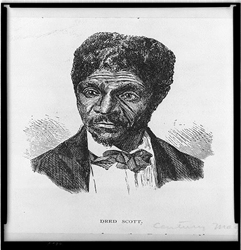
Source: Portrait, Dred Scott, Library of Congress
The 19th century brought about great change for the new nation as it began to grow. The nation grew not only in population but also in geographic size. The map below represents the new boundaries of the United States and its territories by 1810.
In 1803, President Thomas Jefferson approved one of the most important real estate deals of the 19th century. He authorized the payment of 15 million dollars for the territory of Louisiana, an area larger than Portugal, Spain, Italy, Germany, France, and England combined. This deal was known as the Louisiana Purchase.
Click on the map below.
The United States continued to expand during the 19th century, but it also experienced growing pains that accompanied its expansion. The westward expansion of the United States continued to cause conflict with the American Indians who had inhabited these lands for years. They felt their rights had been violated, but their rights were not recognized by the American government or the settlers who continued to move west and take over their lands.
→ Map Analysis: Look at the map below and click on the area where the Indian Reserve provided by the Proclamation of 1763 had been located.
Slavery in the southern states was another issue that led to rapidly growing regional differences. Cotton was the single most important crop of the southern states, and those states depended on slaves as cheap labor. The North was fast becoming more industrialized, and the industries did not require slave labor.
The addition of the land from the Louisiana Purchase encouraged westward movement, and soon there were applications for new states to be admitted into the union. The settlers in these areas wanted to become a part of this growing nation.
In 1820, the Missouri Territory applied for statehood. If admitted as a slave state, Missouri would change the balance between the number of slave states and the number of free states. This issue of slavery caused much controversy and debate within Congress. The opposing sides came to an agreement called the Missouri Compromise (1820).
Click on the Missouri Territory in the map below to read more about this compromise.
One of the most famous events to test the boundaries and balance of free and slave states in the United States was the Dred Scott Supreme Court case.

Source: Portrait, Dred Scott, Library of Congress
In 1846 a slave named Dred Scott and his wife, Harriet, sued for their freedom in a St. Louis city court. They thought they could win the case. They had lived with their owner, an army surgeon, at Fort Snelling, which was in the Wisconsin Territory. The Scotts felt their freedom could be established on the grounds that they were enslaved for extended periods in a free territory (Wisconsin) and were then returned to a slave state (Missouri.) Courts had ruled this way in the past. However, what appeared to be a lawsuit between two private parties became an 11-year legal struggle that resulted in one of the most controversial decisions ever issued by the United States Supreme Court.
Imagine that you are a Supreme Court justice and you have just heard the Dred Scott case. How would you decide this case? Do you believe that the Scotts should be given their freedom since they had been held as slaves in a free territory for a long period of time and then returned to a slave state? Since slaves did not have any rights during this period in history, do you believe the Scotts should not be given any rights by the Supreme Court?
In your notes, write your decision and explain why you made your decision. After you have finished writing your decision, click on the document below and compare your answer to the actual Supreme Court decision.
Interactive popup. Assistance may be required.
Dred Scott decision: On its way to the United States Supreme Court, the Dred Scott case grew in scope and significance as slavery became the single most explosive issue in American politics. By the time the case reached the high court, it had come to have enormous political implications for the entire nation. On March 6, 1857, Chief Justice Roger B. Taney read the majority opinion of the Court, which stated that black people were not citizens of the United States and therefore could not expect any protection from the federal government or the courts. The opinion also stated that Congress had no authority to ban slavery from a federal territory. The decision of Scott v. Sanford, considered by legal scholars to be the worst ruling ever rendered by the Supreme Court, was overturned by the 13th and 14th Amendments to the Constitution, which abolished slavery and declared all persons born in the United States to be citizens of the United States.
- excerpt from www.ourdocuments.gov

Sources of images and interactives used for this section as they appear, top to bottom: